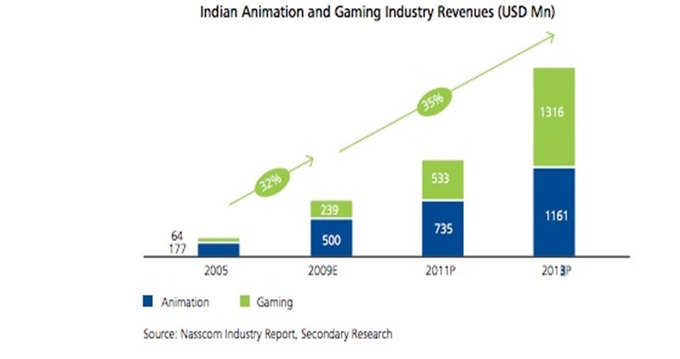 Near the end of 2013, the animated movie
Near the end of 2013, the animated movie Mahabharat was a phenomenal flop.
But much of it had to do with the low quality animation that people ended up watching on-screen. And the studio blamed for such below-par work was a Juhu-based one called Pen India Pvt Ltd. Surely, there was nothing wrong with the story – Mahabharat is one of the most popular epics in the world. And the voice-acting was top-notch. So the only factors behind the debacle were the quality of animation and marketing.
Outsourcing kills creativity
Like many other industries, animation in India earns most of its revenues through outsourced projects from American and European studios. According to a secondary research presented in the

While that is good news from a business standpoint, the increasing number of outsourced projects also means that the animators are constantly working under strict deadlines and their project work is always under remote supervision which hardly leaves any room for creative decision-making. For the global studios, the Indian animation talent is akin to a sweatshop where the designs and plans are already in place and the workers are only expected to execute them. Such an environment not only tramples upon creativity but also leaves little time to pursue one’s creative aspirations. The few animators who choose not to work for those studios often find it difficult to earn a decent living. This is because the domestic market for animation is quite small. In 2009, domestic projects only accounted for 30% of the total revenues the industry earned. The rest came from outsourced animation, gaming and VFX work.
Failure to woo the target audience
As animated movies are relatively new in India, one of the biggest mistakes happened in figuring out the right content for a particular demographic. If you were to look at some of the animated films that came from India and achieved very little success, you might end up thinking – here’s a country where kids love Hindu mythology.
It might seem odd now but that’s exactly what the producers had in mind when they released movies like Ramayan, Chhota Bheem, Ghatotkach, Krishna, etc. All of these feature stories from Hindu mythology and as India has the largest Hindu population, the producers just assumed that these stories would be popular. What a wrong assumption to make! What they don’t realise is that these stories are already known to Indian kids and they are not getting anything new or original out of these films. However, the Indian film industry is partly to blame for this – originality has never been its strong point.
Animation film-makers of India need to learn from studios like
Training counts
Animation can be taught while sketching is a talent that is honed over a longer period of time. So, the first thing wannabe animators need to know is that you need to love art, drawing and sketching. In India, people often choose animation as a career just because it is a booming sector. Five years ago, they might have chosen biotechnology or marine engineering for the same reason. But that’s not the way to go about choosing a career. There are a handful of really good schools in India for learning animation, illustration or design – such as the National Institute of Design (NID), Srishti School of Art and Design,
The future of animation in India can go either way. If we can come up with a few studios which will devote resources and talent for consistently creating really good content and art, the production will be on par with the industry leaders. A good marketing team can then sell it to the world. But without such initiatives, animation in India may just end up being a prop for creating logos for production houses and meeting deadlines for other studios who will get all the credit for creativity.